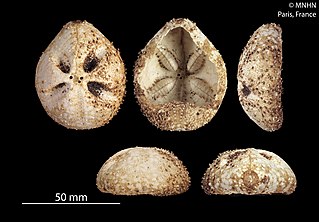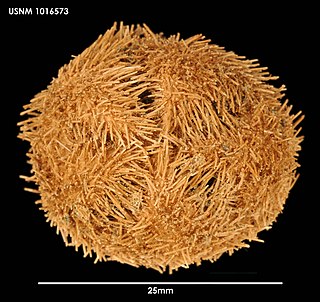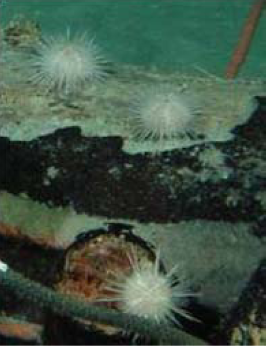Amphipneustes bifidus is a species of sea urchin. Their armor is covered with spines. It is placed in the genus Amphipneustes and lives in the sea. Amphipneustes bifidus was first scientifically described in 1950 by Ole Mortensen, a Danish scientist.

Amphipneustes brevisternalis is a species of sea urchin. Their armour is covered with spines. It is placed in the genus Amphipneustes and lives in the sea. Amphipneustes brevisternalis was first scientifically described in 1926 by Koehler.

Amphipneustes davidi is a species of sea urchin. Their armour is covered with spines. It is placed in the genus Amphipneustes and lives in the sea. Amphipneustes davidi was first scientifically described in 2010 by Madon-Senez.

Amphipneustes koehleri is a species of sea urchin. Their armour is covered with spines. It is placed in the genus Amphipneustes and lives in the sea. Amphipneustes koehleri was first scientifically described in 1905 by Ole Mortensen.
Amphipneustes mironovi is a species of sea urchin. Their armour is covered with spines. It is placed in the genus Amphipneustes and lives in the sea. Amphipneustes mironovi was first scientifically described in 1991 by Markov.
Amphipneustes rostratus is a species of sea urchin. Their armour is covered with spines. It is placed in the genus Amphipneustes and lives in the sea. Amphipneustes rostratus was first scientifically described in 1926 by Koehler.
Amphipneustes tumescens is a species of sea urchin. Their armour is covered with spines. It is placed in the genus Amphipneustes and lives in the sea. Amphipneustes tumescens was first scientifically described in 1926 by Koehler.
Anabrissus damesi is a species of sea urchin of the family Brissidae. Their armour is covered with spines. It is placed in the genus Anabrissus and lives in the sea. Anabrissus damesi was first scientifically described in 1881 by Alexander Agassiz, American scientist and engineer.

Anametalia grandis is a species of sea urchin of the family Brissidae. Their armour is covered with spines. It is placed in the genus Anametalia and lives in the sea. Anametalia grandis was first scientifically described in 1950 by Ole Mortensen.

Araeosoma alternatum is a species of sea urchin of the family Echinothuriidae. Its armour is covered with spines. It is placed in the genus Araeosoma and lives in the sea. A. alternatum was first scientifically described in 1934 by Ole Theodor Jensen Mortensen, a Danish zoologist.
Araeosoma belli is a species of sea urchin of the family Echinothuriidae. Its armour is covered with spines. It is placed in the genus Araeosoma and lives throughout the Caribbean Sea as well as areas around the Gulf of Mexico. A. belli was first scientifically described in 1903 by Ole Theodor Jensen Mortensen, a Danish zoologist.

Araeosoma owstoni is a species of sea urchin of the family Echinothuriidae. Its armour is covered with spines. It is placed in the genus Araeosoma and lives in the sea. A. owstoni was first scientifically described in 1904 by Ole Theodor Jensen Mortensen.

Araeosoma parviungulatum is a species of sea urchin of the family Echinothuriidae. Its armour is covered with spines. It is placed in the genus Araeosoma and lives in the sea. A. parviungulatum was first scientifically described in 1934 by Ole Theodor Jensen Mortensen.
Araeosoma splendens is a species of sea urchin of the family Echinothuriidae. Its armour is covered with spines. It is placed in the genus Araeosoma and lives in the sea. A. splendens was first scientifically described in 1934 by Ole Theodor Jensen Mortensen.
Araeosoma violaceum is a species of sea urchin of the family Echinothuriidae. Its armour is covered with spines. It is placed in the genus Araeosoma and lives in the sea. A. violaceum was first scientifically described in 1903 by Ole Theodor Jensen Mortensen.

Arbaciella elegans is a species of sea urchin of the family Arbaciidae. Their armour is covered with spines. It is placed in the genus Arbacia and lives in the sea. Arbaciella elegans was first scientifically described in 1910 by Ole Theodor Jensen Mortensen.

Asterechinus elegans is a species of sea urchin of the family Trigonocidaridae. Their armour is covered with spines. It is the only species in the genus Asterechinus and lives in the sea. Asterechinus elegans was first scientifically described in 1942 by Ole Theodor Jensen Mortensen.
Brissopsis persica is a species of sea urchins of the Family Brissidae. Their armour is covered with spines. Brissopsis persica was first scientifically described in 1940 by Ole Theodor Jensen Mortensen.
Brissopsis similis is a species of sea urchins of the family Brissidae. Their armour is covered with spines. Brissopsis similis was first scientifically described in 1948 by Ole Theodor Jensen Mortensen.
Amphipneustes is a genus of echinoderms belonging to the order Spatangoida.










